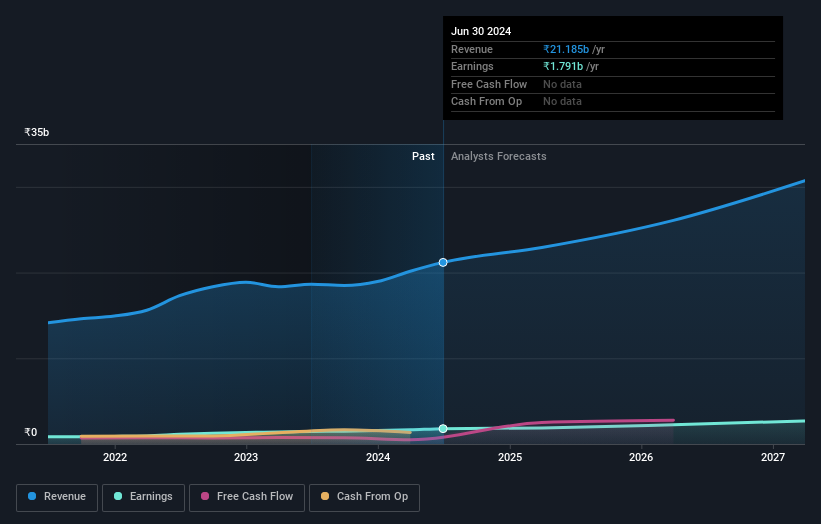- India
- /
- Auto Components
- /
- NSEI:FIEMIND
Following recent decline, Fiem Industries Limited's (NSE:FIEMIND) top shareholder Top Key Executive Jagjeevan Jain sees holdings value drop by 11%

Key Insights
- Fiem Industries' significant insider ownership suggests inherent interests in company's expansion
- A total of 4 investors have a majority stake in the company with 58% ownership
- Using data from analyst forecasts alongside ownership research, one can better assess the future performance of a company
If you want to know who really controls Fiem Industries Limited (NSE:FIEMIND), then you'll have to look at the makeup of its share registry. And the group that holds the biggest piece of the pie are individual insiders with 60% ownership. That is, the group stands to benefit the most if the stock rises (or lose the most if there is a downturn).
And last week, insiders endured the biggest losses as the stock fell by 11%.
In the chart below, we zoom in on the different ownership groups of Fiem Industries.
View our latest analysis for Fiem Industries

What Does The Institutional Ownership Tell Us About Fiem Industries?
Institutional investors commonly compare their own returns to the returns of a commonly followed index. So they generally do consider buying larger companies that are included in the relevant benchmark index.
Less than 5% of Fiem Industries is held by institutional investors. This suggests that some funds have the company in their sights, but many have not yet bought shares in it. So if the company itself can improve over time, we may well see more institutional buyers in the future. When multiple institutional investors want to buy shares, we often see a rising share price. The past revenue trajectory (shown below) can be an indication of future growth, but there are no guarantees.

Hedge funds don't have many shares in Fiem Industries. Because actions speak louder than words, we consider it a good sign when insiders own a significant stake in a company. In Fiem Industries' case, its Top Key Executive, Jagjeevan Jain, is the largest shareholder, holding 21% of shares outstanding. Seema Jain is the second largest shareholder owning 21% of common stock, and Aanchal Jain holds about 8.6% of the company stock. Note that two of the top three shareholders are also Senior Key Executive and Member of the Board of Directors, respectively, once again pointing to significant ownership by company insiders.
After doing some more digging, we found that the top 4 shareholders control more than half of the company's shares which essentially means that there is concentrated ownership amongst the top shareholders, most of whom happen to be insiders!
While it makes sense to study institutional ownership data for a company, it also makes sense to study analyst sentiments to know which way the wind is blowing. Quite a few analysts cover the stock, so you could look into forecast growth quite easily.
Insider Ownership Of Fiem Industries
While the precise definition of an insider can be subjective, almost everyone considers board members to be insiders. The company management answer to the board and the latter should represent the interests of shareholders. Notably, sometimes top-level managers are on the board themselves.
I generally consider insider ownership to be a good thing. However, on some occasions it makes it more difficult for other shareholders to hold the board accountable for decisions.
It seems that insiders own more than half the Fiem Industries Limited stock. This gives them a lot of power. That means they own ₹23b worth of shares in the ₹39b company. That's quite meaningful. Most would be pleased to see the board is investing alongside them. You may wish todiscover (for free) if they have been buying or selling.
General Public Ownership
The general public-- including retail investors -- own 36% stake in the company, and hence can't easily be ignored. While this size of ownership may not be enough to sway a policy decision in their favour, they can still make a collective impact on company policies.
Next Steps:
While it is well worth considering the different groups that own a company, there are other factors that are even more important. For example, we've discovered 1 warning sign for Fiem Industries that you should be aware of before investing here.
Ultimately the future is most important. You can access this free report on analyst forecasts for the company.
NB: Figures in this article are calculated using data from the last twelve months, which refer to the 12-month period ending on the last date of the month the financial statement is dated. This may not be consistent with full year annual report figures.
New: AI Stock Screener & Alerts
Our new AI Stock Screener scans the market every day to uncover opportunities.
• Dividend Powerhouses (3%+ Yield)
• Undervalued Small Caps with Insider Buying
• High growth Tech and AI Companies
Or build your own from over 50 metrics.
Have feedback on this article? Concerned about the content? Get in touch with us directly. Alternatively, email editorial-team (at) simplywallst.com.
This article by Simply Wall St is general in nature. We provide commentary based on historical data and analyst forecasts only using an unbiased methodology and our articles are not intended to be financial advice. It does not constitute a recommendation to buy or sell any stock, and does not take account of your objectives, or your financial situation. We aim to bring you long-term focused analysis driven by fundamental data. Note that our analysis may not factor in the latest price-sensitive company announcements or qualitative material. Simply Wall St has no position in any stocks mentioned.
About NSEI:FIEMIND
Fiem Industries
Manufactures and supplies automotive lighting and signaling equipment, rear view mirrors, and sheet metal and plastic parts in India and internationally.
Flawless balance sheet established dividend payer.
Market Insights
Community Narratives



